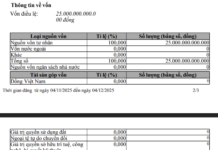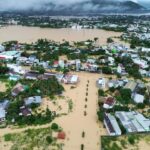Forest conservation is pivotal for Vietnam to achieve its net-zero target by 2050, amidst ongoing challenges of deforestation, natural forest degradation, and inefficient production forest management, which contribute to natural resource depletion and increased greenhouse gas emissions.
Vietnam aims to maintain a stable national forest cover ranging from 42% to 43%, plant approximately 238,000 hectares of new forests annually, and explore natural forest restoration to combat climate change. To gain a comprehensive understanding of the current situation and develop forests towards the net-zero goal, the Center for Natural Resources and Environment Communication of the Ministry of Natural Resources and Environment, in collaboration with the Vietnam Economic Magazine and partners, organized a workshop titled “Maximizing Forest Benefits towards Net-Zero and Sustainable Development Goals.”

Delivering the opening remarks at the workshop, Dr. Chu Van Lam, Vice President of the Vietnam Economic Association, and Editor-in-Chief of Vietnam Economic Magazine/VnEconomy/Vietnam Economic Times, emphasized the significance of forestry in Vietnam, a tropical country with a predominantly hilly terrain, accounting for 3/4 of its territory.
“We all clearly understand that forests are invaluable. They hold immense economic and environmental value, manifested in four prominent aspects: economic, environmental, cultural, and hydrological,” Dr. Chu Van Lam stressed.
Firstly, the economic value of forests lies in providing timber and non-timber forest products, significantly contributing to the income of people and the economy.
Secondly, in terms of environmental value, forests play a crucial role in supplying oxygen, regulating the climate, serving as habitats for various species, conserving genetic resources, and promoting biodiversity. Forests also aid in mitigating climate change and reducing the greenhouse effect.
Thirdly, the cultural value of forests is intertwined with the natural beauty, history, and long-standing traditions of Vietnamese ethnic groups. Forests not only create majestic landscapes but also symbolize the intimate relationship between humans and nature.
Fourthly, the hydrological value of forests is equally important. Forests act as natural “water reservoirs” and “giant fog pumps,” helping to regulate the climate and hydrological system. They reduce the force of rainfall, prevent soil erosion, mitigate flooding, and increase natural water storage capacity, thereby maintaining climate balance and protecting habitats.
“Reflecting on the values of forests, especially at this moment, we are all deeply aware, as the northern region and particularly the mountainous provinces in the north have just endured severe losses from Storm Number 3,” expressed Dr. Chu Van Lam. Vietnam is among the top 10 countries with the highest carbon emission growth rates globally and has significant potential for carbon credit supply, including from the agriculture sector, such as livestock farming and crop production, with forests being a key contributor.

With over 14.8 million hectares of forests, Vietnam currently boasts a forest cover of 42.02%, absorbing and storing significant amounts of carbon. It is estimated that Vietnamese forests can generate between 50 and 70 million tons of surplus forest carbon credits, potentially earning thousands of billions of dong if successfully exported.
Promoting multi-value forest development is a growing trend in Vietnam. Apart from the direct values derived from timber, non-timber products, and hydropower (currently accounting for only about 15% of the forest ecosystem’s value), other significant benefits include non-timber products and services. Among them, developing the forest carbon market is a key focus. This is evident in the Project on Developing the Multi-purpose Value of the Forest Ecosystem by 2030, with a vision towards 2050, approved by the Government earlier in 2024.
“Consequently, forest benefits should be further exploited and promoted effectively and sustainably to meet new requirements and advance towards the net-zero targets that Vietnam has committed to,” affirmed Dr. Chu Van Lam.
Regarding the financial value of climate finance and forest carbon finance, these are novel concepts with promising opportunities for Vietnam. They have garnered significant attention from various economic entities, especially local governments, businesses, investors, financial institutions, and banks. However, the legal framework and policies are still being developed and refined. Therefore, it is crucial for entities to accurately and comprehensively understand these matters. This holds great significance in ensuring the successful implementation of Vietnam’s development goals in this field.
The Green Pioneer: Heineken Vietnam’s Journey to Net Zero and Beyond
Despite facing a challenging year, HEINEKEN Vietnam remains committed to its sustainability ambitions, recently unveiling impressive achievements in its journey towards net-zero emissions by 2023.








































